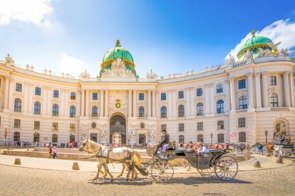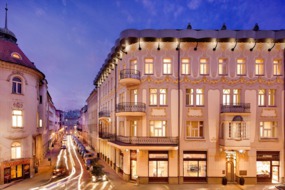
3 November
Setting sail from Vilshofen
Vilshofen an der Donau is known as the 'Little Town of Three Rivers', situated at the point where the Vils and Wolfach flow into the Danube. At its heart is the delightful old town, home to several interesting buildings including the Church of St John the Baptist, the Benedictine Abbey of Schweiklberg and the iconic clock tower.

4 November
Germany: Passau

The pretty Bavarian town of Passau, situated close to Germany’s border with Austria, enjoys a unique setting at the confluence of three rivers: the Inn, the Ilz and the Danube. The narrow cobbled streets of the handsome old town, the Altstadt, are quite delightful.
5 November
Austria: Linz (Salzburg)

The city of Linz is included on river cruise itineraries due to its proximity to Salzburg, which is where you’ll most likely be headed. Salzburg’s Altstadt attracts millions of visitors every year with its fairytale skyline of domes and spires, and the city is renowned as both the birthplace of Mozart and the setting for ‘The Sound of Music’.
5 November
Austria: Grein
6 November
Austria: Melk

The riverside village of Melk is best known for its spectacular abbey, a Baroque masterpiece that dominates the landscape. A Benedictine abbey was first established here in 1089, and the 18th century reconstruction that you can see today is still a working monastery.
6 November
Austria: Spitz
7 November
Austria: Vienna

Formerly the centre of the Habsburg Empire, Vienna is as grand a European capital as you can imagine, jam packed full of thrusting, bombastic buildings that stand as a reminder of Austria’s glorious imperial heyday.
8 November
Slovakia: Bratislava

Bratislava, Slovakia’s quaint little capital, straddles the Danube close to the border with Austria and Hungary. The compact old town is the best place to begin your exploration, before heading up to the hilltop castle for commanding views of the city and surrounding countryside.
9-10 November
Arriving in Budapest
Budapest is one of Eastern Europe's most appealing cities, a vibrant and welcoming capital that straddles the Danube. The history of Budapest has been somewhat turbulent - ransacked by the Mongols in 1241, occupied by the Ottoman Turks for over a century, and almost flattened by the Soviets in 1945 - but plenty of older buildings survive, including the imposing Parliament and iconic St Stephen's Basilica. Although a pedant might point out that Budapest has only really existed since 1873; up until then the city's two distinct halves, Buda and Pest, were separate towns.


Our tip
Hungarian cuisine is vastly underrated; don’t visit Budapest without trying goulash, the paprika-infused national dish.
Your home from home



AmaMagna represents a bold new ship design for the Danube, the same length but twice the width of a standard river cruise vessel, with more space, larger staterooms and more dining options.
What we love
The extra space on board AmaMagna means large, luxurious, ocean-type staterooms averaging over 300 square feet, lots of dining options, and expansive spa and fitness areas. There will also be something totally new - a retractable watersports platform.
| Capacity | 196 Guests |
|---|---|
| Crew | 70 European Staff |
| Style |
Relaxed and informal during the day, giving way to an elegant evening atmosphere. |
| Inclusions |
|
Tailor-make your trip

Our favourite hotel in Budapest
We like the Hotel Palazzo Zichy on the Pest side of the river, which used to be the residence of Count Nándor Zichy.

A taste of Hungary
If you’re a wine lover, you really should visit the world’s oldest classified wine region, known for its sweet Tokaji aszú dessert wine.










